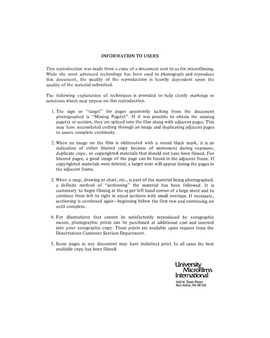| dc.contributor.author | Loeffler, Margaret Howard, | en_US |
| dc.date.accessioned | 2013-08-16T12:28:35Z | |
| dc.date.available | 2013-08-16T12:28:35Z | |
| dc.date.issued | 1982 | en_US |
| dc.identifier.uri | https://hdl.handle.net/11244/5007 | |
| dc.description.abstract | The research was designed to test the theory by testing predictions of children's behaviors derived from the theoretical assumptions. These predictions were: that particular threshold levels of competence in spoken language (linguistic awareness) and in graphic representation (intention) must be attained before protowriting could occur; and that protowriting and its prerequisite behaviors were organized and coordinated by the same underlying cognitive structures that support more general non-linguistic, intellectual behaviors. | en_US |
| dc.description.abstract | The spontaneous writing of young children who have not yet learned to read was the subject of this study. Previous research of this behavior, usually termed invented spelling, has investigated its relationship to children's phonological knowledge, cognitive development, and developing reading skills. This study examined the behavior within a more general developmental framework, relating it both to individual development and to human evolution. The term protowriting was used to describe the behavior, indicating the child's intention to write for communication rather than to spell. | en_US |
| dc.description.abstract | Seven tasks, including protowriting and its prerequisite behaviors and four infralogical and logical Piagetian tasks, were given to forty-eight (four, five, and six-year-old) male and female subjects. Performances on each of the tasks were evaluated on a five-stage developmental scale. | en_US |
| dc.description.abstract | Building upon the contemporary ontogeny/phylogeny models suggested by the works of S. Gould, E. Bates, J. Lamendella, K. Gibson and S. Parker, it was postulated that protowriting is an adaptive behavior in the present developmental sequence that has had high adaptive value in human history and has emerged historically as a new behavior constructed from two universal behaviors previously adapted for other functions, spoken language and graphic representation. Although writing is not universal, it is a behavior available to all humans if the environment supports and/or requires its development. | en_US |
| dc.description.abstract | The data supported the assumption that significant relationships exist between developmental levels of protowriting and the suggested prerequisite behaviors, spoken language and graphic representation, and that threshold levels of competence in these behaviors must be attained before protowriting can occur. The data partially support the assumption that common cognitive structures underlie performances on all seven tasks. | en_US |
| dc.format.extent | vii, 101, [8] leaves : | en_US |
| dc.subject | Anthropology, Cultural. | en_US |
| dc.title | An investigation of the relationship of protowriting (invented spelling) and cognitive development in young children. | en_US |
| dc.type | Thesis | en_US |
| dc.thesis.degree | Ph.D. | en_US |
| dc.thesis.degreeDiscipline | Department of Anthropology | en_US |
| dc.note | Source: Dissertation Abstracts International, Volume: 43-05, Section: A, page: 1601. | en_US |
| ou.identifier | (UMI)AAI8224200 | en_US |
| ou.group | College of Arts and Sciences::Department of Anthropology | |
